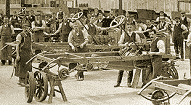 |
Car Building |
 |
 |
Car Building |
 |
|
Queen Victoria never saw an aeroplane. That is not surprising. What may be more surprising is that she never got into a motor car. It was the Germans, Daimler and Benz who, in 1885, first used a petrol engine to drive a vehicle. From there on the development of the motor car was largely carried out by the Germans and the French. The British were severely hampered by Acts of Parliament. Those laws had been passed to deal with what were seen as the problems and dangers presented by earlier British ingenuity, steam carriages and traction engines. The Locomotive Act of 1861 provided that "locomotives" – and this meant almost any self-propelled vehicle – should be in the charge of at least two people and was not to exceed 10 miles an hour on a turnpike road or two miles an hour when passing through any town or village. In 1865 things got worse with the passing of an amending Act which became known as the "Red Flag Act", since it required a third person to be present, walking in front of the locomotive, carrying a red flag and warning all approaching it that a locomotive was coming. And the Act reduced the speed limit to 4 mph on the highway and maintained it at 2 mph in towns and villages. Then the Highways and Locomotives (Amendment) Act 1878 authorised every county council to licence locomotives at £10 a time – and you had to pay the £10 to every county you entered.
These restrictions were apparently tolerable for traction engines, and around 8,000 of them were on the road in 1895. But since the Acts applied even to light motor cars, and motor cars were seen as recreational vehicles of no great economic importance, they were enough to smother car building in the UK. But developments on the continent started to make it clear that motor vehicles were becoming far more useful than mere playthings of the rich. Parliament was eventually persuaded to change the law and the Locomotives on Highways Act, 1896 distinguished between vehicles of less than 3 tons unladen weight and those over that weight; and it permitted the lighter vehicles to travel on the highway at a speed set by the Local Government Board up to 14 mph. The Board (a government department, very roughly the equivalent of a Department of the Environment, or some such) settled the speed at 12 mph. The Motor Car Act, 1903 increased the speed limit to 20 mph and in 1904 an Order under that Act introduced provision for "heavy motor cars" which were, in effect, lorries and commercial vehicles. Thus separated out from traction engines and given enough freedom on the road, the private car and commercial vehicle industry in this country could be established and flourish. And flourish it did. By the end of 1910 there were 124,860 "light motor cars" on UK roads. Wolverhampton and the Black Country became world famous for their motor cars. All kinds were produced from the luxurious Sunbeam's and Star's to the mass produced Clyno's. Wolverhampton and Black Country built cars also broke the world land speed record on several occasions, and Sunbeam played an important part in the racing scene. Some of the earliest cars were produced here thanks to Thomas Parker, a brilliant inventor who claimed to have built an electrically powered car as early as 1884. In 1896 one of his sons built his famous 'Electric Dog Cart' at the E.C.C. Works.
Economic historians usually attribute the distribution of the British car industry to its being established in places where bicycles had been made and say that accounts for the original centres of manufacture being Coventry, Birmingham and Wolverhampton. But the histories of individual firms in Wolverhampton might not fully bear that out as the only explanation. Almost anyone with a bit of technical know how could try to produce a car; you did not need to learn to build a bicycle first. What you also needed was finance, access to materials and parts and, even more importantly, the kind of entrepreneurial ability and sheer drive that Samuel Smiles would have approved of. Look at the individual histories we have on this site and see how the Wolverhampton and Black Country motor industry came about. By the late 1890's both Star and Sunbeam were thinking about producing cars commercially. Edward Lisle purchased a Benz 'Velo' for the Star Cycle company with the idea of reverse engineering it, and the first Star car was born. Within a few years the Sunbeam Mabley appeared. It was built under license having been designed by Mr. Mabley Smith. 1902 saw the appearance of the first Turner car which was steam driven. It was a version of the well known Belgian 'Miesse' steam car for which Turner's had acquired the manufacturing rights. Briton cars appeared in 1909 to produce the cheaper Star models after Star had decided to concentrate on the more expensive end of the market, and in 1922 Clyno cars appeared. The motorcycle manufacturer was to become the 3rd largest car manufacturer in the U.K. During the First World War the industry concentrated on war work. Production consisted of vehicles for the armed forces, aero engines, munitions, or general machining. After the war production continued to expand, the industry even rode-out the depression of the 30s. The economies of scale however, lead to a contraction in the number of car makers, and by the end of the second world war there were only a few, but large, manufacturers left in the UK. Thereafter international competition saw off most of the British "light motor car" industry. Luckily many fine examples of locally made cars have been preserved and can still be seen in car museums and collections, such as the one at the Black Country Living Museum. |